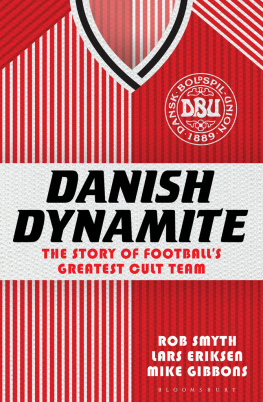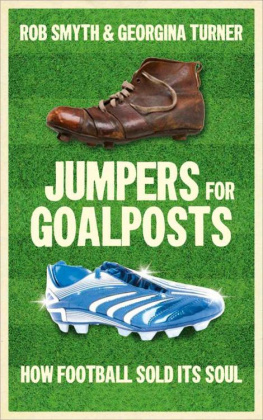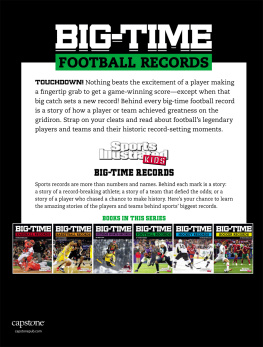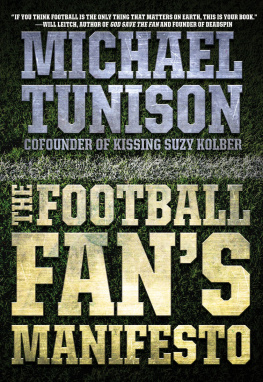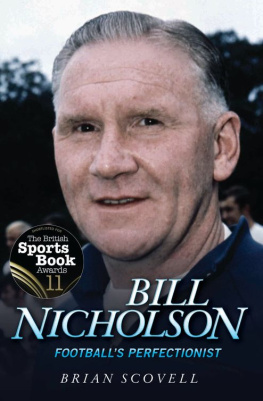
To Sepp and the boys of 86, who made football fun
In the 2010s Denmark became one of the worlds most fashionable countries. There were myriad reasons for this, from Nordic noir to gastronomy via architecture, craft beer and even knitwear. Football fans of a certain age wondered what took everyone else so long to discover this. In the mid-1980s, Denmark were the most interesting and perhaps the best football team in the world, an almost unprecedented achievement for a country with a population of only five million.
What Denmark did was amazing, said Diego Maradona. They were like a bullet train. They made history by playing football from the future: a fast-forward version of the Dutch Total Football that had charmed the world in the 1970s, and with the same unashamedly attacking intent.
Denmarks style made children fall in love with football and reminded adults why they had fallen in love with it in the first place. When the influential British magazine World Soccer asked a group of experts in 2008 to select the greatest teams of all time, Denmarks 1980s side were sixteenth on the list above any side from Argentina, Spain, Germany, Liverpool, Manchester United or Internazionale. The Danish fans gave their team a simple and enduring name: Danish Dynamite.
The team were just as impressive off the field: warm, funny, laid back and approachable sometimes in four or five different languages. The same was true of their fans, who followed their team abroad in their thousands and extended the mood of innocence with their cheery, peaceful drunkenness that was in contrast to the hooliganism elsewhere during the 1980s.
Around 80 per cent of the population watched a famous match at Wembley, and the players were adored for what they achieved and especially the way they achieved it. Before Danish Dynamite, Denmark for decades had been an irrelevant football country; they were happy amateurs, content with mediocrity, who did not question their place in the wider scheme. That all changed in 1979, year zero for Danish football.
In those days foreign football was only really available during the World Cup, so for those of a certain age Denmark were the first great fantasy team. In the days before the internet and social media, discovering them was like finding a great underground band or art house film. The fact that their story had a bittersweet tang and a doomed innocence only accentuates their alternative appeal. The best stories in life are the ones where those involved dont get the girl, the happy ending or even the Jules Rimet Trophy.
More than three decades later the Dynamite team are still big news whether its newspaper tributes when they turn sixty, when songs from 1986 are played on the radio or when toddlers sport the teams kit from the mid-1980s. That kit is a seriously expensive piece of memorabilia from an era that also produced ultra-quotable dialogue from the TV commentator Svend Gehrs and unlikely tributes from obsessive fans overseas. Danish Dynamite is also the name of an award-winning beer made by Stonehenge Ales in Salisbury, Wiltshire, and, in 2010, the Danish embassy in Tokyo arranged for a Japanese pop group to film their own version of Re-Sepp-Ten, Denmarks song from the 1986 World Cup.
The team were even special guests at a wedding in another country in 2012. On 10 May, Mr Dave Bignell and Ms Claire Whitehead were married at St Ninians Church in Douglas on the Isle of Man. The twelve tables at the reception were named after the Denmark team that played Uruguay at the 1986 World Cup: Rasmussen, Busk, Olsen, Nielsen, Andersen, Arnesen, Berggreen, Bertelsen, Lerby, Laudrup and Elkjr. The starting XI was accompanied by the coach, Sepp Piontek, who naturally took the grandparents table. Michael Laudrup was chosen for the top table, with Preben Elkjr and Sren Lerby proving especially popular among those who had been told of their character and on-field exploits.
The team have been a constant reference point in my life, says Dave Bignell. He is certainly not alone in that.
The introduction of football in Denmark was half a beat behind the trailblazers in the North of England. It was led by Kjbenhavns Boldklub (KB), the oldest football club in continental Europe, in 1879. The first football match in Denmark was played in 1883 and six years later Dansk Boldspil-Union (the Danish Football Association, or DBU) was formed. It set up the national championship and provided organisation to a sport whose popularity had been spreading among English immigrants and in boarding schools. The DBU was in on the ground floor as one of seven founder members of Fifa in 1904.
The Danes were handy on the pitch too an unofficial Danish national team won gold at the 1906 Intercalated Games held to mark the ten-year anniversary of the original Olympics in Athens. After sweeping into a 9-0 lead at half-time in the final, Denmark were crowned champions when their Greek opponents refused to come out for further punishment in the second half.
Two of the early stars of Danish football were Niels and Harald Bohr, siblings who achieved fame in Denmark and beyond as a kind of scholarly version of the Neville brothers in the early twentieth century. Both played for Akademisk Boldklub just north of Copenhagen. Niels was a useful goalkeeper who never ascended to the national side. If youre going to overcompensate for not being an international footballer, you might as well go big. He went on to win the Nobel Prize in Physics in 1922, worked on the Manhattan Project during the Second World War, founded CERN (where the internet was invented), was the first recipient of the Atoms for Peace award and has an element in the periodic table Bohrium named in his honour.
His younger brother, Harald, did make it as a Danish international and was also a mathematician of some repute. Rare indeed is the man who can dovetail an international football career with pioneering work in the study of almost periodic functions. He also had a theorem named after him. Harald missed the chance to play in Denmarks unofficial triumph in 1906 as he was helping Niels defend his doctoral thesis, but did play a starring role in Denmarks first official international matches at the London Olympics in 1908. They claimed a silver medal and an Olympic record, walloping France A by a score of 17-1. (They had managed a mere nine goals against Frances B team in the previous round.) They lost the final to Great Britain, as they would again in the 1912 Olympics in Stockholm.
Perhaps they would have won in 1912 had Poul Tist Nielsen been fit. He had just begun a career of goalscoring abandon that would make Gerd Mller look profligate by comparison. Nielsen shot KB to six Danish championships and, in a fifteen-year international career, scored fifty-two times in thirty-eight matches. Norway were his bread and butter and on the receiving end of half of his goals in one game against them in 1917, in which the kick-off was delayed while the Danish left-back and shoe salesman Johannes Hansen was stuck at the hairdressers, Nielsen struck five times in eleven minutes. When he scored his fiftieth international goal against Belgium in 1924, the Danish goalkeeper Edvin Frigast Larsen ran the length of the pitch to shake his hand and bow before him.
As Nielsens career wound down, the early burst of amateur success faded. After going out of the 1920 Olympics in the first round, Denmark retreated into international hibernation. They could not afford further attempts at Olympic glory and settled for matches against Finland, Sweden and Norway and the odd friendly with other European nations within easy hitting distance. Elsewhere, the idealistic French football president Jules Rimet launched the World Cup in Uruguay in 1930, a professional tournament to find the best team in the world that would quickly put the amateur Olympic equivalent in the shade. Denmark adhered to their amateur principles and declined to enter.
Next page
